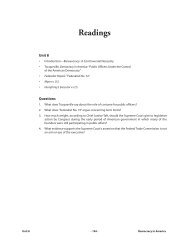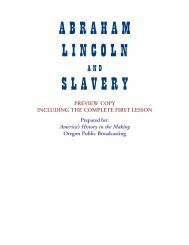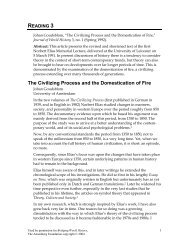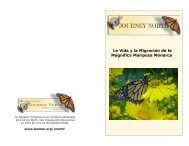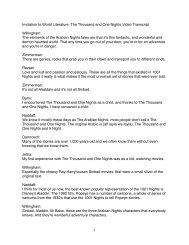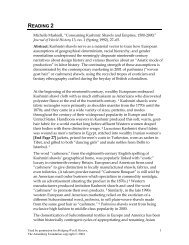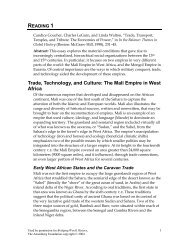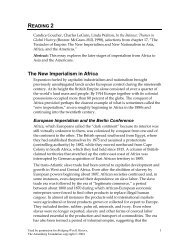UTOPIAN PROMISE - Annenberg Media
UTOPIAN PROMISE - Annenberg Media
UTOPIAN PROMISE - Annenberg Media
You also want an ePaper? Increase the reach of your titles
YUMPU automatically turns print PDFs into web optimized ePapers that Google loves.
deceased individual and expressed orthodox ways of understanding<br />
human mortality. Typical gravestone iconography ranged from traditional<br />
symbols of the transitory nature of earthly existence (skulls,<br />
skeletons, hourglasses, scythes) to emblems suggesting the possibility<br />
of resurrection and regeneration (wings, birds, flowers, trees, the sun).<br />
Eventually, gravestones also came to include representations of<br />
cherubs and human forms.<br />
One of the most common images found on early Puritan gravestones<br />
is the winged death’s-head, prominent on the pediment of the<br />
Joseph Tapping stone (Boston, 1678). At first glance, the image seems<br />
grim and despairing, a visual corollary to the Latin inscriptions on the<br />
lower right panel of the stone (Vive Memor Loethi and Fugit Hora, or<br />
“Live mindful of death” and “Time is fleeting”). Yet the wings attached<br />
to the death’s-head suggest the possibility of resurrection and ascension<br />
to heaven, thus pictorially signifying the conceptual duality of<br />
Puritan attitudes toward death as both a fearful event and a potential<br />
means to eternal salvation. The architectural symbolism of columns<br />
and tablets on the Reverend Abraham Nott stone (Essex, Connecticut,<br />
1756) similarly functions as a visual emblem of apocalyptic thinking,<br />
suggesting the rebuilding of the temple and the Second Coming of<br />
Christ as it is prophesied in Revelation. With their iconographic fusion<br />
of religious and aesthetic values, gravestones offer important evidence<br />
about the interrelationship of spiritual concerns and attitudes toward<br />
death in Puritan culture.<br />
QUESTIONS<br />
Comprehension: What kinds of images decorate the gravestones featured<br />
in the archive? Which images are most prominent? What do<br />
you think the images would have signified to Puritan viewers? How<br />
might the images have offered spiritual comfort to those mourning<br />
the dead?<br />
Comprehension: Basing your opinion on the gravestones featured in<br />
the archive, how do you think Puritan gravestones changed over<br />
time? How might these differences reflect shifts in cultural values?<br />
Comprehension: What is the concept of “election” in Puritan theology?<br />
Read Anne Bradstreet’s spiritual reflections in her letter “To My<br />
Dear Children.” How does she struggle with her faith and the question<br />
of her own election? What conclusions does she come to?<br />
Context: In sermons delivered in the 1630s and 1640s, the Puritan<br />
minister John Cotton predicted that the Apocalypse would occur<br />
within the next fifteen years. Years later, at the end of the seventeenth<br />
century, his grandson Cotton Mather asserted that Puritans<br />
should expect the Apocalypse very soon. Using the timeline provided<br />
in this unit, examine the events that were occurring in New<br />
England in the 1630s, 1640s, and 1690s when these predictions<br />
were made. Why do you think Puritans living in this period would<br />
have felt that the end of the world was near at hand? What events<br />
and anxieties might have made these apocalyptic predictions seem<br />
realistic?<br />
[4563] Anonymous, The Joseph<br />
Tapping Stone, King’s Chapel, Boston,<br />
Massachusetts (1678), courtesy of<br />
Wesleyan University.<br />
“APOCALYPSE” WEB<br />
ARCHIVE<br />
[2121] Anonymous, Goffe Rallying the<br />
men of Hadley (1883), courtesy of the<br />
Library of Congress [LC-USZ62-75122].<br />
Indian attacks on villages in western<br />
Massachusetts during King Philip’s War<br />
challenged the viability of English settlement<br />
in New England and led many to<br />
question why they had fallen so far from<br />
God’s favor and to wonder whether the<br />
Apocalypse was near.<br />
[3370] Anonymous, The Rebekah<br />
Gerrish Stone (1743), courtesy of<br />
Wesleyan University Press. This stone<br />
depicts the conflict between time and<br />
death: a candle is flanked by a skeleton<br />
on the left, about to snuff out the fire,<br />
and a winged angel on the right, with<br />
an hourglass in hand, making a prohibitive<br />
gesture toward the skeleton. This<br />
dispute reflects the dual nature of time<br />
and Judgment found in Wigglesworth’s<br />
“Day of Doom” and the more concrete<br />
dualism of the Apocalypse: some will be<br />
sent to hell and some to heaven.<br />
APOCALYPSE 35



